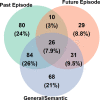Constructive episodic simulation in dreams
- PMID: 35316266
- PMCID: PMC8939783
- DOI: 10.1371/journal.pone.0264574
Constructive episodic simulation in dreams
Abstract
Memories of the past help us adaptively respond to similar situations in the future. Originally described by Schacter & Addis in 2007, the "constructive episodic simulation" hypothesis proposes that waking thought combines fragments of various past episodes into imagined simulations of events that may occur in the future. This same framework may be useful for understanding the function of dreaming. N = 48 college students were asked to identify waking life sources for a total of N = 469 dreams. Participants frequently traced dreams to at least one past or future episodic source (53.5% and 25.7% of dreams, respectively). Individual dreams were very often traced to multiple waking sources (43.9% of all dreams with content), with fragments of past memory incorporated into scenarios that anticipated future events. Waking-life dream sources are described in terms of their phenomenology and distribution across time and sleep stage, providing new evidence that dreams not only reflect the past, but also utilize memory in simulating potential futures.
Conflict of interest statement
The authors have declared that no competing interests exist.
Figures




Similar articles
-
The memory sources of dreams: serial awakenings across sleep stages and time of night.Sleep. 2023 Apr 12;46(4):zsac292. doi: 10.1093/sleep/zsac292. Sleep. 2023. PMID: 36462190 Free PMC article.
-
Memory sources of dreams: the incorporation of autobiographical rather than episodic experiences.J Sleep Res. 2014 Aug;23(4):441-7. doi: 10.1111/jsr.12134. Epub 2014 Feb 19. J Sleep Res. 2014. PMID: 24635722
-
Dreams reflect nocturnal cognitive processes: Early-night dreams are more continuous with waking life, and late-night dreams are more emotional and hyperassociative.Conscious Cogn. 2021 Feb;88:103071. doi: 10.1016/j.concog.2020.103071. Epub 2020 Dec 25. Conscious Cogn. 2021. PMID: 33360822
-
Dreaming during REM sleep: autobiographically meaningful or a simple reflection of a Hebbian-based memory consolidation process?Arch Ital Biol. 2018 Sep 1;156(3):99-111. doi: 10.12871/00039829201832. Arch Ital Biol. 2018. PMID: 30324606 Review.
-
The reinterpretation of dreams: an evolutionary hypothesis of the function of dreaming.Behav Brain Sci. 2000 Dec;23(6):877-901; discussion 904-1121. doi: 10.1017/s0140525x00004015. Behav Brain Sci. 2000. PMID: 11515147 Review.
Cited by
-
Memory updating in dreams.Sleep Adv. 2024 Dec 18;5(1):zpae096. doi: 10.1093/sleepadvances/zpae096. eCollection 2024. Sleep Adv. 2024. PMID: 39749230 Free PMC article.
-
Dreamers' evaluation of the emotional valence of their day-to-day dreams is indicative of some mood regulation function.Front Behav Neurosci. 2022 Sep 16;16:947396. doi: 10.3389/fnbeh.2022.947396. eCollection 2022. Front Behav Neurosci. 2022. PMID: 36187381 Free PMC article.
-
The next step in understanding the function of dreams.Sleep. 2023 Apr 12;46(4):zsad010. doi: 10.1093/sleep/zsad010. Sleep. 2023. PMID: 36656722 Free PMC article. No abstract available.
-
The memory sources of dreams: serial awakenings across sleep stages and time of night.Sleep. 2023 Apr 12;46(4):zsac292. doi: 10.1093/sleep/zsac292. Sleep. 2023. PMID: 36462190 Free PMC article.
-
Peering into the future: Eye movements predict neural repetition effects during episodic simulation.Neuropsychologia. 2024 May 3;197:108852. doi: 10.1016/j.neuropsychologia.2024.108852. Epub 2024 Mar 18. Neuropsychologia. 2024. PMID: 38508374 Free PMC article.
References
Publication types
MeSH terms
LinkOut - more resources
Full Text Sources
Miscellaneous

